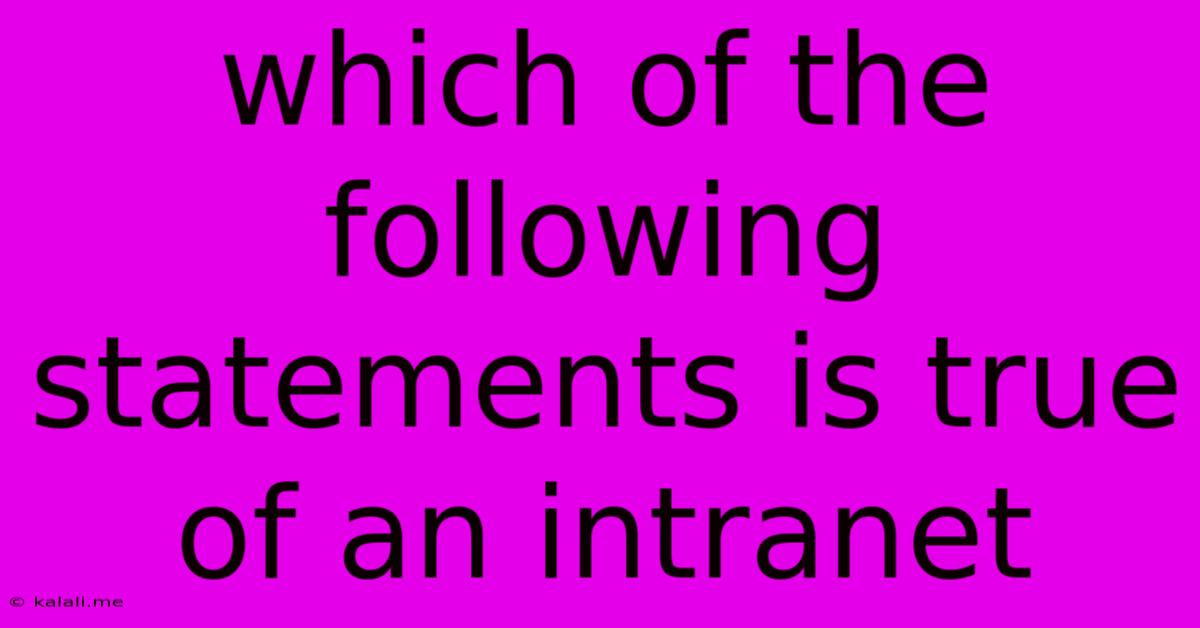Which Of The Following Statements Is True Of An Intranet
Kalali
Jun 16, 2025 · 3 min read

Table of Contents
Which of the Following Statements is True of an Intranet? Demystifying Internal Networks
Meta Description: Confused about intranets? This article clarifies what an intranet is and isn't, explaining its key characteristics and differentiating it from the internet and extranets. Learn which statements about intranets are true and which are false.
An intranet is a private network accessible only to authorized users within an organization. It's often misunderstood and frequently confused with the internet or extranets. This article will clarify the key characteristics of an intranet and help you determine which statements about them are true. We'll explore its functionality, security measures, and the benefits it offers businesses.
What is an Intranet?
An intranet is essentially a private network that uses internet technologies (like HTTP, HTML, and TCP/IP) to share information and resources within a company or organization. Unlike the public internet, access is restricted to authorized personnel, ensuring data security and confidentiality. Think of it as a company's internal website, accessible only to employees, contractors, or other designated users.
Key Characteristics of an Intranet:
- Security: Intranets employ strong security measures like firewalls, access controls, and encryption to protect sensitive data from unauthorized access. This is a crucial difference from the open nature of the internet.
- Privacy: Information shared on an intranet remains confidential within the organization. This is essential for protecting intellectual property, sensitive employee data, and strategic business information.
- Collaboration: Intranets facilitate collaboration through tools like shared calendars, document sharing platforms, and internal communication channels. This improves teamwork and efficiency.
- Communication: Intranets serve as a central hub for internal communication, distributing announcements, news, and company policies efficiently.
- Cost-effectiveness: By centralizing information and streamlining communication, intranets can reduce costs associated with printing, distributing documents, and managing information silos.
- Accessibility: Authorized users can typically access the intranet from anywhere with an internet connection, using various devices like desktops, laptops, tablets, and smartphones.
- Customization: Intranets can be customized to meet the specific needs and requirements of an organization. This includes branding, features, and functionalities.
Common Intranet Applications:
- Employee directories: Easily find contact information for colleagues.
- Company policies and procedures: Quick access to essential internal documents.
- Project management tools: Streamline collaboration on projects.
- Training and development materials: Provide employees with easy access to learning resources.
- Internal news and announcements: Keep employees informed about company news and events.
- Discussion forums: Facilitate communication and collaboration among employees.
Intranet vs. Internet vs. Extranet:
It's crucial to differentiate an intranet from the internet and extranets. The internet is a global public network, while an extranet extends some intranet functionalities to authorized external users, such as suppliers or clients. The key difference lies in the level of access and security.
Evaluating Statements About Intranets:
Now, let's consider various statements about intranets and determine their veracity. To accurately assess the truthfulness of a statement, consider the characteristics outlined above. A true statement will align with the features and purpose of a secure, internal corporate network dedicated to improving communication and collaboration among authorized personnel. For example, a statement claiming an intranet is publicly accessible would be false. A statement emphasizing its role in secure internal information sharing would be true.
By understanding the core principles of an intranet, you can easily discern true statements from false ones. Remember to consider the aspects of security, privacy, internal access, and the facilitation of communication and collaboration within an organization. This understanding is key to appreciating the value and importance of intranets in modern business operations.
Latest Posts
Latest Posts
-
How To Create Clickable Image In Html
Jun 16, 2025
-
What Are The Factors Of 121
Jun 16, 2025
-
What Is A Theme Of The Passage
Jun 16, 2025
-
A Company That Provides Access To The Internet
Jun 16, 2025
-
Which Word Is Closest In Meaning To The Underlined Word
Jun 16, 2025
Related Post
Thank you for visiting our website which covers about Which Of The Following Statements Is True Of An Intranet . We hope the information provided has been useful to you. Feel free to contact us if you have any questions or need further assistance. See you next time and don't miss to bookmark.